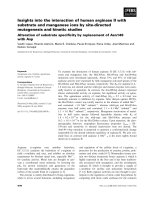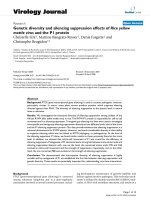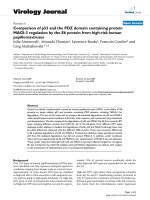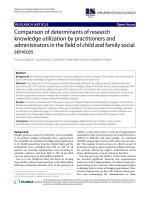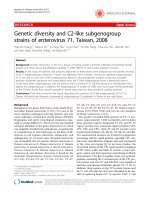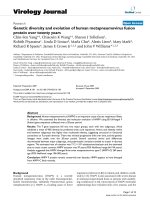Comparison of the cytoplastic genomes by resequencing insights into the genetic diversity and the phylogeny of the agriculturally important genus brassica
Bạn đang xem bản rút gọn của tài liệu. Xem và tải ngay bản đầy đủ của tài liệu tại đây (1.03 MB, 7 trang )
Qiao et al. BMC Genomics
(2020) 21:480
/>
RESEARCH ARTICLE
Open Access
Comparison of the cytoplastic genomes by
resequencing: insights into the genetic
diversity and the phylogeny of the
agriculturally important genus Brassica
Jiangwei Qiao1*† , Xiaojun Zhang1†, Biyun Chen1, Fei Huang2, Kun Xu1, Qian Huang1, Yi Huang1, Qiong Hu1 and
Xiaoming Wu1
Abstract
Background: The genus Brassica mainly comprises three diploid and three recently derived allotetraploid species,
most of which are highly important vegetable, oil or ornamental crops cultivated worldwide. Despite being
extensively studied, the origination of B. napus and certain detailed interspecific relationships within Brassica genus
remains undetermined and somewhere confused. In the current high-throughput sequencing era, a systemic
comparative genomic study based on a large population is necessary and would be crucial to resolve these
questions.
Results: The chloroplast DNA and mitochondrial DNA were synchronously resequenced in a selected set of Brassica
materials, which contain 72 accessions and maximally integrated the known Brassica species. The Brassica
genomewide cpDNA and mtDNA variations have been identified. Detailed phylogenetic relationships inside and
around Brassica genus have been delineated by the cpDNA- and mtDNA- variation derived phylogenies. Different
from B. juncea and B. carinata, the natural B. napus contains three major cytoplasmic haplotypes: the cam-type
which directly inherited from B. rapa, polima-type which is close to cam-type as a sister, and the mysterious but
predominant nap-type. Certain sparse C-genome wild species might have primarily contributed the nap-type
cytoplasm and the corresponding C subgenome to B. napus, implied by their con-clustering in both phylogenies.
The strictly concurrent inheritance of mtDNA and cpDNA were dramatically disturbed in the B. napus cytoplasmic
male sterile lines (e.g., mori and nsa). The genera Raphanus, Sinapis, Eruca, Moricandia show a strong parallel
evolutional relationships with Brassica.
Conclusions: The overall variation data and elaborated phylogenetic relationships provide further insights into
genetic understanding of Brassica, which can substantially facilitate the development of novel Brassica germplasms.
Keywords: Brassica, Rapeseed, Cytoplasmic DNA, Maternal origin, Evolutionary relationship, Cytoplasmic male
sterility
* Correspondence:
†
Jiangwei Qiao and Xiaojun Zhang contributed equally to this work.
1
Key Laboratory of Biology and Genetic Improvement of Oil Crops, Ministry
of Agriculture and Rural Affairs, Oil Crops Research Institute of the Chinese
Academy of Agricultural Sciences, Wuhan, China
Full list of author information is available at the end of the article
© The Author(s). 2020 Open Access This article is licensed under a Creative Commons Attribution 4.0 International License,
which permits use, sharing, adaptation, distribution and reproduction in any medium or format, as long as you give
appropriate credit to the original author(s) and the source, provide a link to the Creative Commons licence, and indicate if
changes were made. The images or other third party material in this article are included in the article's Creative Commons
licence, unless indicated otherwise in a credit line to the material. If material is not included in the article's Creative Commons
licence and your intended use is not permitted by statutory regulation or exceeds the permitted use, you will need to obtain
permission directly from the copyright holder. To view a copy of this licence, visit />The Creative Commons Public Domain Dedication waiver ( applies to the
data made available in this article, unless otherwise stated in a credit line to the data.
Qiao et al. BMC Genomics
(2020) 21:480
Background
The genus Brassica in Brassicaceae family is one of the
most agriculturally important plant genera worldwide,
which mainly comprises three diploid and three allotetraploid species, as described in the genetic model of U’s
Triangle [1]. Brassica napus (AACC, 2n = 38), B. juncea
(AABB, 2n = 36) and B. carinata (BBCC, 2n = 34) are
thought to be generated by interspecific hybridizations
between each two of the three basic diploid progenitors:
B. rapa (AA, 2n = 20), B. oleracea (CC, 2n = 18) and B.
nigra (BB, 2n = 16). The current abundant genomic and
phenotypic diversifications have given rise to highly diverse crops of vegetable, oil, ornamental, fodder and
fertilizer use types. To date, B. napus (rapeseed) has become to be the second largest vegetable oil crop worldwide [2]. Recently, the release of certain reference
genome sequences has drived Brassica as an ideal model
for studying polyploidy [3–7].
B. napus is supposed to originate from certain kind of
hybridization between B. rapa and B. oleracea, which
co-existed in European Mediterranean coastwise regions,
at approximately 10,000 years ago [4]. Then it has diffused worldwide (mainly to Asia, America and
Australia), and eventually formed several ecological and
morphological types, which mainly include winter,
spring and semi-winter ecotypes or oil-use, roottuberous and leafy morphotypes. Recently, extensive
resequencing and analyses on nuclear DNA concerning
the mechanisms for the progenitors, evolution and improvement of this versatile crop have been performed.
Phylogenomic analyses combining diverse B. napus and
its potential progenitors revealed that winter type rapeseed might be the original form of B. napus, European
turnip ancestor might donate the A subgemone, the origin of C subgenome is mysterious and it was currently
supposed to evolve from a common ancestor of cultivated C-genome species (kohlrabi, cauliflower, broccoli,
and Chinese kale) [8]. The A and C subgenomes evolved
asymmetrically and higher genetic diversity was identified in A subgenome [9].
To date, the genuine originating mechanisms of B.
napus remain largely unresolved. The frequent postformation introgression events occurred during human
breeding consequentially confused the recovery of the
originating trajectory of B. napus at nuclear genome
level. Cytoplasmic DNA in plant cell, especial for chloroplast DNA (cpDNA), are structurally simple with a small
genome size (100–300 kb) and stably inherited mostly in
a uniparental pattern with nearly none recombination
[10]. Thus, it has been extensively employed in the
phylogenetic studies [11–14]. Genotyping by using six
chloroplast SSR primer pairs or TILLING analysis, one
most prevalent cpDNA haplotype was identified in B.
napus [15, 16]. While, the B. napus of this same cpDNA
Page 2 of 15
haplotype generally formed an ambiguous clade, which
did not group with the investigated B. rapa or B. oleracea accessions [17], implying its mysterious origin. A
few B. napus accessions were grouped with the majority
of B. rapa accessions suggested another independent
cytoplasmic origin from B. rapa [9, 18], indicating that
has multiplex maternal origins. The mitochondrial DNA
(mtDNA) of B. napus has drawn much more attention
for the extensive application of its cytoplasmic male sterility (CMS) lines in the heterosis-driving hybrid breeding, mainly containing polima (pol), cam and nap
mitotypes in the natural resources [17]. Nap mitotype is
predominant in natural B. napus, However, it remains
unsolved and were supposed to be from an unidentified
or lost mitotype of B. rapa [19]. The nap mitotype was
further judged to be derived from B. oleracea, since it
was phylogenetically grouped with botrytis-type and
capitata-type B. oleracea [20].
Apparently, the current above conclusions regarding
the origin of nap-type B. napus are controversial and
ambiguous. Previous cpDNA and mtDNA-based studies
were separated and never been corresponded and integrated to accurately explore the multiply origin of B.
napus. Cytoplasmic DNA and its corresponding cytonuclear interactions, are highly valuable for crop breeding not only due to its cause of cytoplasmic male
sterility [21], but also in the association with certain
agricultural traits, e.g., high seed-oil content in nap-type
rapeseed [22] and plant resistance to adverse living environment. Here in this study, a well-chosen set of plant
materials centering on B. napus have been synchronously resequenced at the cpDNA and mtDNA level, a
systematic genetic investigation and an elaborate phylogenetic pedigree at intraspecific level have been constructed, with the purpose of improving our
understanding of the whole Brassica genus.
Results
Sequencing of the diverse cytoplasmic Brassica DNA
haplotypes
To distinguish the cytoplasmic DNA (cpDNA and
mtDNA) haplotypes within Brassica genus, genotyping
analysis through High Resolution Melting (HRM)
method were performed in our germplasm collections
(Figure S1). Primers were designed being targeted on a
set of intra/inter-specific cpDNA polymorphic sites that
were identified previously [16] (Table S1). Three major
haplotypes were identified in approximately 480 worldwide B. napus accessions. Two major cpDNA haplotypes
were identified in 180 B. rapa accessions, while 180 B.
juncea accessions contain one major cpDNA haplotype.
B. oleracea, B. carinata, B. nigra, B. maurorum (MM,
2n = 16), certain wild C-genome relatives and three B.
napus cytoplasmic male sterility (CMS) lines were
Qiao et al. BMC Genomics
(2020) 21:480
Page 3 of 15
treated as each with a distinct haplotype for the subsequent genome sequencing. B. cretica, B. incana, B. insularis and B. villosa represent the wild C-genome
relatives. Polima [23, 24], nsa [25] and mori [26, 27] are
the CMS lines. Certain relative materials, i.e. Eruca
sativa (2n = 22), Raphanus sativus (2n = 18), Sinapis
arvensis (2n = 24) and Moricandia arvensis (2n = 28),
were also included to enrich this study (Table S2).
Cytoplasmic DNA was synchronously isolated from 72
accessions that represent for all major cytoplasmic haplotypes and morphological varieties (Table S2), using an
optimized organelle isolation procedure (Materials and
Methods). This method can substantially help to remove
nuclei and balance the proportions of cpDNA and
mtDNA content. Reads mapping analysis demonstrated
that the isolated total DNA contains an average ratio of
37.2% chloroplast DNA and 3.4% mitochondrial DNA,
respectively, which is approximately 5–10 times higher
than the ratio of cytoplasmic DNA in the total leaf DNA
[28]. The cytoplasmic DNA mixture was then subjected
to the high-throughput sequencing (with average sequencing depths above 500 x, Table 1). The obtained
paired-end reads (150 bp) were directly mapped to a tandem sequence gather, which consists of 10 published
chloroplast genome sequences across Brassicaceae family. The mapped reads were extracted and de novo assembled by SOAPdenovo software package [29].
Generally, two or three large contigs were eventually
generated for the chloroplast genomes. Gaps were directly filled through manual jointing of the overlapping
ends of each two contiguous contigs, and then verified
by Sanger sequencing of the gap-spanning PCR fragments. All the obtained chloroplast genome sequences
are provided in Additional file 3 (Appendix A).
Genome-wide cytoplasmic (cpDNA and mtDNA) variations
in Brassica
The chloroplast and mitochondrial genome sequences of
a B. napus strain 51,218 [22], which is an intermediate
breeding material of nap mitotype, were respectively
used as reference sequences to call the overall cpDNA
and mtDNA basic variants. The calling was conducted
by standard BWA/Genome Analysis Toolkit (GATK)
pipeline with manual inspection [30], and then randomly
Table 1 Sequencing information of the representative materials
Species (names)
Entry
Number
Discriptions
Total
Data
(G)
Data of chloroplast genomes
B. rapa ssp. oleifera
A22
B. rapa ssp. oleifera
B. juncea
Data of mitochondrial genomes
oilseed use
3.20
1.74
54.44% 11,387
0.22
6.95%
1002
A173
oilseed use
3.34
1.91
57.11% 12,467
0.17
5.11%
769
AB81
oilseed use
5.69
1.21
21.18% 7877
0.12
2.06%
529
B. juncea var. tumida
AB180
vegetable use (Zha-cai)
3.47
0.82
23.78% 5386
0.06
1.60%
250
B. napus
AC32
Cam-type cytoplasm
6.90
1.90
27.54% 12,418
0.22
3.21%
998
B. napus
AC399
Polima-type cytoplasm
4.53
2.65
58.59% 17,347
0.12
2.66%
542
B. napus (Zhongshuang11)
AC457
Nap-type cytoplasm
9.37
3.90
41.60% 25,480
0.96
10.21% 4311
Data (G) Rations Average depth Data (G) Rations Average depth
B. napus (Darmor)
AC489
Nap-type cytoplasm
8.14
3.31
40.70% 21,647
0.59
7.23%
2649
B. napus (Mori sterile line)
AC490
Recombinant cytoplasm 5.37
2.24
41.70% 14,637
0.41
7.58%
1834
B. napus (Nsa sterile line)
AC497
Recombinant cytoplasm 5.87
0.91
15.51% 5948
0.06
0.94%
250
Brassica insularis
C1
wild species
7.23
3.08
42.59% 20,111
0.21
2.89%
943
Brassica oleracea var. oleracea C3
wild species
4.19
1.79
42.76% 11,710
0.14
3.24%
612
Brassica cretica
C5
wild species
4.36
1.67
38.41% 10,947
0.18
4.20%
825
Brassica villosa
C11
wild species
8.73
2.00
22.94% 13,090
0.19
2.15%
847
Brassica oleracea var. italica
C16
cultivar (Broccoli)
3.35
1.29
38.43% 8402
0.08
2.33%
352
Brassica nigra
B2
wild species
6.29
0.54
8.66%
3561
0.05
0.72%
204
B.maurorum
Maurorum-1
wild species
2.63
0.97
36.73% 6314
0.05
2.01%
238
Brassica carinata
BC2
cultivar
3.94
1.72
43.70% 11,254
0.23
5.76%
1022
Sinapis arvensis
Sinapis1
wild species
6.67
2.24
33.60% 14,649
0.32
4.76%
1431
Sinapis arvensis
Sinapis3
wild species
7.76
2.43
31.28% 15,866
0.12
1.61%
563
Raphanus sativus
Raphanus-1
cultivar
7.55
2.44
32.32% 15,951
0.34
4.49%
1527
Moricandia arvensis
Moricandia-1 wild species
7.23
2.95
40.83% 19,295
0.22
3.05%
992
Eruca sativa
Eruca-1
6.55
1.78
27.14% 11,619
0.30
4.63%
1366
cultivar
Qiao et al. BMC Genomics
(2020) 21:480
verified by Kompetitive Allele Specific PCR (KASP) analysis. A total of approximately 4700 reliable basic polymorphic sites, including 3880 SNP and 820 InDels,
respectively, were identified for all the sequenced
chloroplast haplotypes in Brassica genus. While, approximately 3400 polymorphic sites (2700 SNP and 700
InDels) were identified for the mitochondrial haplotypes (Table S3). The average SNP density in the
chloroplast and mitochondrial genomes was 25 and 12
SNPs per kilo base (kb), respectively. The chloroplast
variants were uniformly distributed along the reference
genome, except the two 26-kb large inverted repeat regions, IRa and IRb (Fig. 1), since these genomic regions
were skipped due to the repetitive mapping of the same
reads. The mitochondrial variants showed a comparatively even distribution pattern along the reference genome; however, their variation frequencies are obviously
much higher at the regions containing the open reading
frame (ORF) genes (Fig. 2).
Page 4 of 15
Among the overall variants, 13.9 and 18.1% were identified as nonsynonymous for 47 cpDNA coding genes
and 61 mtDNA coding genes, respectively. The materials
of two B. napus mitochondrial haplotypes, below known
as cam- and polima-types, possess approximately 300
basic variants when referring to B. napus strain 51,218
mitochondrial genome of nap-type. Polima-type is close
to cam-type with a difference of only about 50 conserved
cpDNA variants (Table S3). Consistent difference patterns were also found for cpDNA variants as for the three
cytoplasmic types. KASP analysis using the primers targeted to the B. napus mitotype-corresponding mtDNA
and cpDNA polymorphic sites detected that nap, cam and
polima cytoplasms accounted for 87.1, 7.2 and 5.7% in the
investigated B. napus population (Figure S2). Undoubtedly, nap-type is the predominant cytoplasmic DNA
haplotype, as identified in previous studies [15, 16]. Most
of the B. rapa materials are of the same cam-type in B.
napus, another major haplotype accounting for a
Fig. 1 Genomic distribution of the basic cpDNA variants in the sequenced materials. The map was drawn using Circos ( The
innermost circle represents for the chloroplast genome map of B. napus strain 51,218. The inner bottle-green bars and outer laurel-green bars
correspond to the distribution of SNPs and InDels within nonoverlapping 500-bp bins across the entire genome, respectively. The length of each
bar denotes the total number of basic variants in a 500-bp region, take the value as 30 if it exceeds 30. None variants appeared in two inverted
repeat regions, IRa (83–109 kb) and IRb (126–153 kb)
Qiao et al. BMC Genomics
(2020) 21:480
Page 5 of 15
Fig. 2 Genomic distribution of the basic mtDNA variants in the sequenced materials. The map was drawn using the same procedure as for Fig. 1.
The innermost circle represents for the mitichondrial genome map of B. napus strain 51,218. The inner bottle-green bars and outer laurel-green
bars correspond to the distribution of SNPs and InDels, respectively
frequency of approximately 5.8% in the investigated B.
rapa population has been identified and named as sarsontype hereinafter, since it mainly exists in B. rapa var. sarson accessions.
The phylogeny of Brassica genus conducted based on the
whole chloroplast genomes
Analyses based on the whole chloroplast genomes or
genome-wide variations instead of partial cpDNA fragments can infer a phylogeny with much higher resolution and reliability, even at lower taxonomic levels
[14]. To forecast the evolutionary trajectories of Brassica
crops, all the above-obtained whole chloroplast genomes
were subjected to phylogenetic analysis. The phylogenetic trees tentatively conducted using the Maximum
Likelihood method, neighbor-joining method and Bayesian method were almost identical. To reduce the calculating amount and avoid a corpulent tree, the trees
comprising materials throughout each intra-species,
Brassica genus and Brassicaceae family, respectively,
were conducted stepwise by Maximum Likelihood
method [31].
Chloroplast genome sequences of Raphanus sativus, Isatis
tinctoria, Matthiola incana and Arabidopsis thaliana in
Brassicaceae family (Data from NCBI, Additional file 3)
served as outgroup to root the intra-specific trees. The results indicated that 13 B. rapa accessions, 14 B. juncea accessions, 24 B. napus accessions and 13 C-genome species each
clustered well and were separately integrated into a speciesspecific group. The B. rapa separated a little branch containing only two accessions, which were classified as sarson-type
cytoplasm mentioned above (Figure S3). The B. juncea accessions did not diverge any secondary branches, indicating
a lack of cytoplasmic genetic diversity (Figure S4). The B.
napus cluster were split into two large branches, one branch
containing the nap-type lines (e.g., the nuclear-genome sequenced cultivars Darmor/AC489 and ZS11/AC457), another branch further split into two little branches, containing
cam-type (e.g., Shengli Rape/AC32) and polima-type (e.g.,
Jianyang Rape/AC399) lines, respectively (Figure S5). All the
Qiao et al. BMC Genomics
(2020) 21:480
investigated cultivated B. oleracea (e.g., Cauliflower, Broccoli,
Cabbage, Kohlrabi) and part of the wild B. oleracea were
shown with one nearly identical chloroplast genome sequence. However, the C-genome wild relatives (B. villosa, B.
insularis, B. cretica and B. incana) each contains a distinct
haplotype. All the C-genome species demonstrated a hierarchically clear pedigree, from B. villosa stepwise to the cultivated B. oleracea (Figure S6).
A part of the above intra-specific materials were selected
capable of maximumly representing each their intraspecific
genetic diversities, and then together with Brassica nigra, B.
carinata and B. maurorum, were combined to construct a
larger tree comprising of materials all over Brassica genus.
The cpDNA sequence data for materials Root mustard-1 (B.
juncea), Sarsons-1 (B. rapa), Broccoletto-3 (B. rapa), Black
mustard (B. juncea) and Ethiopian mustard (B. carinata)
were added from Li et al., [18] to enrich the whole phylogenetic tree. The results indicated that Brassica genus was
mainly divided into three clades, from which the maternal
origin of the three natural allotetraploid species can be
clearly inferred (Fig. 3). All the B. rapa, B. juncea and quite a
few B. napus accessions of both cam- and polima-type constitute Clade I, which further diverged two little branches
containing B. rapa ssp. trilocularis (Sarsons) and polima-type
B. napus, respectively. Three B. juncea accessions clustered
only in Clade I without any further divergences from their
co-clustered B. rapa accessions, thus indicating that the investigated B. juncea has a monophyletic maternal origin
from cam-type B. rapa. Clade II comprises all the B. oleracea
lines and other wild C-genome species, parallelly branched
with Clade I. The branch, which comprises only the B. napus
accessions with a same nap cytoplasmic type, is inserted in
the middle of Clade II and separated certain C-genome wild
relatives (B. insularis and B. villosa) from the remaining part,
which contains all B. cretica, B. incana and the cultivated B.
oleracea. Clade III comprises mainly B. nigra, B. carinata
and B. maurorum accessions, indicating that the investigated
B. carinata has a monophyletic maternal origin from B.
nigra. The major cytoplasmic haplotype of B. nigra was designated as nigra-type cytoplasm. The wild species B. maurorum had been reported to be close to the B-genome species
[32] and seems evolved earlier than all the remaining part in
Clade III. The topological branches in this tree displayed a
clear hierarchical pedigree, from Clade III to Clade I (Fig. 3).
Taken together, different from B. juncea and B. caritana, B.
napus was dispersedly distributed in the B. rapa and B. oleracea clusters, suggesting its multiple maternal origins from
A-genome B. rapa or certain C-genome Brassica species
(2n = 18).
The evolution of Brassica tightly associates with a set of
its close genera
Intriguingly, Raphanus sativus was inserted between
Clade II and Clade III and bidirectionally close to B.
Page 6 of 15
villosa and B. maurorum in the Brassica phylogenetic
tree (Fig. 3), suggesting certain association between
Raphanus genus and Brassica phylogeny. To explore
whether any more other genus also mingle with Brassica
genus, a phylogenetic tree containing 54 (Thirteen in and
41 beyond Brassica genus) chloroplast genome sequences
in Brassicaceae family was constructed (Fig. 4). The tree
displays an evolutionary pedigree with a clear hierarchical
architecture. The Brassicaceae family was basically divided
into two large lineages, containing Arabidopsis/Matthiola
and Draba/Brassica genera, respectively, which is congruent with the previous studies [33, 34]. Another three materials, Eruca sativa, Moricandia arvensis and Sinapis
arvensis, were also identified to be tightly integrated with
the evolution of Brassica genus. Eruca sativa and Moricandia arvensis were located at the same positions as
Raphanus sativus, while three herein sequenced and one
public Sinapis arvensis (Sinapis-4) accessions displayed
scattered distribution that is fully merged together with
the B-genome containing species in Clade III. These findings imply a tight evolutionary association among Brassica
and these relatives. Cakile arabica, Orychophragmus diffusus, Alliaria grandifolia, Isatis tinctona and Scherenkiella
parvula in Clade IV were shown to be close to Brassica
cluster at cytoplasmic DNA level. Successful germplasm
development through inter-specific sexual or somatic
hybridization between Brassica species with Orychophragmus violaceus or Isatis tinctona [35, 36] could partially
support that the species in Clade IV are fairly close to
Brassica.
Uncoupled inheritance of chloroplast and mitochondrial
genomes in B. napus CMS lines
Mitochondrial genome represents another half set of
cytoplasmic DNA. To ascertain how about the Brassica
phylogeny if being inferred based on mitochondrial genomes, the segmented sequences containing the mitochondrial allelic variants from each corresponding
material inside and around Brassica genus were extracted and concatenated as each separate intact sequence. All the assembled sequences were subjected to
phylogenetic analysis according to the above same procedure used for chloroplast genomes. The obtained
mitochondrial tree (Fig. 5) displayed a pedigree largely
resembling the tree that was derived based on cpDNA
(Fig. 3). Likewise, it also diverged into three clades, each
of the natural Brassica materials possesses nearly identical evolutionary positions in both the cpDNA and
mtDNA deriving trees, the same maternal origin relationships of the three Brassica allotetraploid crops were
inferred. The location of four genera (Raphanus sativus,
Eruca stivus, Moricandia arvensis and Sinapis arvensis)
in the mtDNA derived tree were also integrated into
Brassica genus, demonstrating that mtDNA evolved
Qiao et al. BMC Genomics
(2020) 21:480
Fig. 3 (See legend on next page.)
Page 7 of 15

